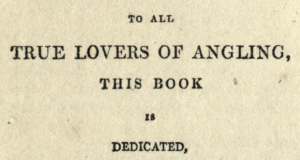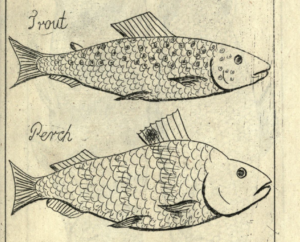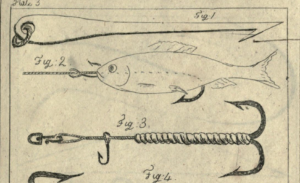Editor’s Note: Last month I offered a guide to the quick and dirty business of gutting a book. Composed mainly for the benefit of graduate students in history, many of whom I see struggling to take command of a large literature and either reading too few books or too many reviews of books as a substitute, my step by step for getting the essence of an argument and its position in the scholarship was greeted with mixed reviews. An anonymous colleague offers, contrapuntal, the below. KW

The dedication to The Complete Angler’s Vade-Mecum (1808) courtesy Biodiversity Heritage Library
Gutting a fish, like gutting a book, is a practical, if brutal, process. You chop off the head, scoop out all the internal organs that kept the creature alive as it swam through the seas, scrape off the scales, and the next thing you know, it’s a nice chunk of consumable protein. The fish is thus efficiently rendered, with a very particular goal in mind. No need to be squeamish—we all need to eat. Let’s just not confuse this process with appreciating the fish in all its fishiness, or gutting with reading.
Graduate students in history, especially when studying for comprehensive exams, need to move through a long list of books very quickly. KW is absolutely right when she argues that her TICCN method–Title (and structure), Introduction, Conclusion, and Notes—is better than the usual options. Better than only getting to page 97 of a 300-page book, better than slogging away into the wee hours every night and harming your health, better than thinking you’ll “know” a book by reading its reviews. KW also wisely cautions that this method of reading is best suited to getting a sense of the topography in a particular field of study. It is not how one ought to read in one’s area of specialty, and not the way people usually read when reading for pleasure.
 Moreover, TICCN resembles the general advice given long ago by the philosopher and educator Mortimer Adler in How to Read a Book (1940), though TICCN is more useful to history graduate students because it is more discipline-specific. Adler talked about three stages in the reading process: (1) the analysis of a book’s structure, which includes identifying the topic addressed and the problem to be solved; (2) the interpretation of the book’s contents, which includes understanding the book’s terminology and locating the author’s propositions and arguments; and (3) criticism: showing where the author is uninformed, misinformed, illogical, or incomplete. Adler taught that with practice, the reader could perform the first two tasks at the same time, but cautioned that the last—criticism—ought to be delayed until the first two were completed. Using the TICCN method, the student will presumably discern the book’s topic and structure from the title and table of contents, and locate the study’s main arguments and central concepts in the introduction, conclusion, and chapter intros and conclusions. Looking at the notes, the student will get a sense both of how the author argues from the evidence and engages the existing scholarly conversation—both crucial to any kind of critical evaluation.
Moreover, TICCN resembles the general advice given long ago by the philosopher and educator Mortimer Adler in How to Read a Book (1940), though TICCN is more useful to history graduate students because it is more discipline-specific. Adler talked about three stages in the reading process: (1) the analysis of a book’s structure, which includes identifying the topic addressed and the problem to be solved; (2) the interpretation of the book’s contents, which includes understanding the book’s terminology and locating the author’s propositions and arguments; and (3) criticism: showing where the author is uninformed, misinformed, illogical, or incomplete. Adler taught that with practice, the reader could perform the first two tasks at the same time, but cautioned that the last—criticism—ought to be delayed until the first two were completed. Using the TICCN method, the student will presumably discern the book’s topic and structure from the title and table of contents, and locate the study’s main arguments and central concepts in the introduction, conclusion, and chapter intros and conclusions. Looking at the notes, the student will get a sense both of how the author argues from the evidence and engages the existing scholarly conversation—both crucial to any kind of critical evaluation.
Still, some caveats are in order. Gutting a book is not the most important mode of reading for a historian. Or, to put it another way, TICCN is a great way to be an efficient consumer of historical knowledge but not a sufficient way to become a producer of historical knowledge. It should go without saying that reading textual primary sources should be an operation that’s conducted closely, carefully, analytically. Slowly. What about secondary sources? Not all arguments are so simple, and not all language so pellucid, that comprehension can occur with a few quick blinks at a chapter’s intro and conclusion. I. A. Richards in How to Read a Page (1942, interestingly subtitled A Course in Efficient Reading) urged readers to slow down, even to the point of sub-vocalizing, because the ear could sometimes detect logical structure that the eye misses. Slowing down to be attentive to the rhythms of language within an argument not only helps readers perceive how arguments are constructed but helps them as writers, constructing arguments themselves. Reading closely and carefully, they see not just how the argument is expressed in the structural relationship of chapters to book but also in paragraphs to chapter and, as Stanley Fish explores in How to Write a Sentence and How to Read One (2011), in the structure of sentences themselves.
 The TICCN method takes most of the contents of each chapter and tosses it out like fish entrails splattered on waste paper. But is the evidence marshalled to support an argument merely a series of interchangeable illustrations reinforcing some general point, or an accumulation of data points or information that gives a conclusion probability like a series of weights added to a scale? This might be true for some forms of social or economic history. But in many other kinds of history—cultural, intellectual, literary, art, and so on—the sources are dense, tangled, multi-layered, multivalent, and difficult. They have to be sifted and probed, unfolded like complex origami figures. The interpretive argument emerges from the careful analysis of the sources themselves. However the interpretive argument may be summarized in an introduction and conclusion, it cannot be reduced to those bare summaries. By ignoring the stuff of the chapters, TICCN risks missing what, in fact, the book is really about.
The TICCN method takes most of the contents of each chapter and tosses it out like fish entrails splattered on waste paper. But is the evidence marshalled to support an argument merely a series of interchangeable illustrations reinforcing some general point, or an accumulation of data points or information that gives a conclusion probability like a series of weights added to a scale? This might be true for some forms of social or economic history. But in many other kinds of history—cultural, intellectual, literary, art, and so on—the sources are dense, tangled, multi-layered, multivalent, and difficult. They have to be sifted and probed, unfolded like complex origami figures. The interpretive argument emerges from the careful analysis of the sources themselves. However the interpretive argument may be summarized in an introduction and conclusion, it cannot be reduced to those bare summaries. By ignoring the stuff of the chapters, TICCN risks missing what, in fact, the book is really about.
Since KW referenced Annette Gordon-Reed, so will I. The great value of Gordon-Reed’s Hemingses of Monticello (2008), it seems to me, is less in the conclusions she comes to or in the sources she cites than in how she takes the reader with her as she reasons her way through the evidence, line by line, and page by page. Though the book is not really in my area of specialization, if I had gutted it with TICCN instead of reading it closely and carefully, I would have missed what’s great about the book.
Where does this leave us? History graduate students, by all means use the TICCN method as needed when plowing quickly through scores of books (outside your area of specialization) for your comprehensive exams, or generally when trying to see the contours of a field of study. Just don’t make this your default mode of reading. An additional caution: when assigning a book for a two-and-a-half-hour seminar, professors do not necessarily expect you to read every single world like a Talmudic scholar hunched over the Torah. But if they are going to devote this much class time to a book, most professors—at least one, anyway!—will expect your comments to be rooted in a closer reading than the gutting described by TICCN.
And there is a curious thing about the verb “to gut.” When referring to fish, the stuff that is extracted from the body is what’s thrown away. When referring to a book, the stuff that’s extracted from the body of the text is thought to be the “essential contents” or the “important passages.” This reversal points to a nagging question: it is not always so easy, when dealing with books or pages or sentences rather than fish, to know at a glance what is important and essential, and what is not—what are good guts, and what are bad.

No Comments